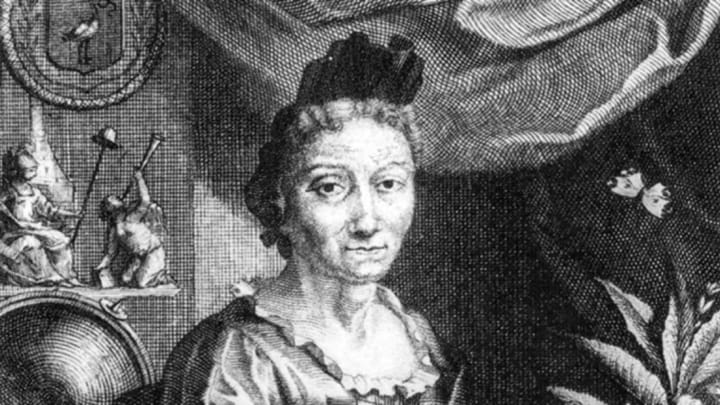During the 17th century, when it was generally believed that insects spontaneously generated from dirt, old wool, and rotten meat, Maria Sibylla Merian found them fascinating. Her work as a naturalist and illustrator led to a new understanding of how insects reproduced and transformed, and her curiosity about the world also repeatedly transformed her own life—a life that was already unconventional for a 17th-century woman.
Merian was born in 1647, the ninth child of well-known German illustrator Matthäus Merian, who died when she was three. As a child she eagerly read books about natural history, and was inspired by the work of the illustrator Georg Flegel, who often drew flowers visited by insects. She also studied art under the guidance of her stepfather, the flower still-life painter Jacob Marrel, who apprenticed under Flegel.
Merian began her insect investigations at the age of 13 by studying silkworms. In the foreword to her most famous book, Metamorphosis of the Insects Of Surinam, Merian described her early research: "I started with silk worms in my hometown of Frankfurt. I realized that other caterpillars produced beautiful butterflies or moths, and that silkworms did the same. This led me to collect all the caterpillars I could find in order to see how they changed.”
A page from Metamorphosis insectorum surinamensium. Image credit: Smithsonian Institution, Public Domain
After marrying her father’s apprentice, Johann Andreas Graff, she moved to Nuremberg, where she continued painting and gave drawing classes. The couple had two daughters, Johanna and Dorothea, but motherhood did not prevent Merian from studying or drawing insects. In 1675, she published the first part of her three-part Blumenbuch, which would showcase a grand total of 36 plates of her own flower engravings. With these illustrations she pursued her interest in portraying insects while also drawing flowers, a more conventional and profitable art subject.
During her time in Nuremberg, Merian also published the first volume of The Caterpillar Book, which described moths and caterpillars throughout their transformation, as well as showing their food sources. Her descriptions of each stage of the insect’s development, from egg to caterpillar to adult, meant that, independently of other researchers at the same time, she had helped disprove spontaneous generation. The illustrations demonstrated that moths and caterpillars did not just spontaneously appear, but were rather predictably born and matured. Because this book was written in the vernacular instead of Latin, however, her scientific discoveries were never really appreciated, and her real contribution came in a more artistic sense. Traditionally, animals had been shown as isolated images. But Merian showed insects interacting with plants, complete with bitemarks on the leaves. For this, she’s considered one of the founders of the “ecological” approach to drawing animals, which emphasized how the insects interacted with the world at large.
In 1686, Merian had left her husband and decided to take her daughters to a utopian community organized by a Protestant religious movement known as the Labadists. The Labadists, named after their founder Jean de Labadie, believed in strict discipline and community property. During her five-year stay, Merian brushed up on her Latin and developed a special interest in the flora and fauna specimens that arrived from a Labadist community in the Dutch colony of Surinam.
“This all resolved me to undertake a great and expensive trip to Surinam (a hot and humid land) where these gentlemen had obtained these insects, so that I could continue my observations,” she later wrote in the foreword to Metamorphosis of the Insects Of Surinam.
A page from Metamorphosis insectorum surinamensium. Image credit: Smithsonian Institution, Public Domain
Around 1691, when the religious community suffered a financial collapse, Merian and her daughters moved to Amsterdam and she officially divorced her husband. Around the same time, her older daughter married a businessman with interests in Surinam. Eager to travel there, Merian financed an expedition by selling hundreds of her paintings.
In 1699, Merian and her daughter Dorothea traveled to Surinam intending to spend five years studying and illustrating insects. But the trip only lasted two years, since malaria forced Merian to return to Amsterdam in 1701. She was one of very few European women to have traveled in pursuit of science at the time, and she did not return empty-handed. Before leaving Surinam, she stocked up on butterflies, fireflies, iguanas, snakes, and turtles. She then opened a curiosity shop selling such specimens. She also set up a studio together with her daughters, both of whom were painters like her.
Between 1701 and 1705, Merian produced 60 copperplate engravings to illustrate insect development. In 1705 she published her most famous book, Metamorphosis of the Insects of Suriname, and sold it by subscription.
Marian’s career ended when she was paralyzed by a stroke in 1715. Two years later she died, just short of her 70th birthday. Shortly before her death, Czar Peter the Great of Russia purchased her watercolors.
A page from Metamorphosis insectorum surinamensium.Image credit: Smithsonian Institution, Public Domain
Respected during her life, Merian was not forgotten. Her daughters continued her work and helped preserve her memory. Daughter Dorothea posthumously published a third volume of her mother’s caterpillar book, with an appendix by daughter Johanna.
Merian’s books were popular in her lifetime, as well as after she died: Between 1680 and 1771, her three books were published 20 times. Merian also lives on in the names of living creatures. A species of lizard, six plants, nine butterflies and two beetles have been named in her honor.
